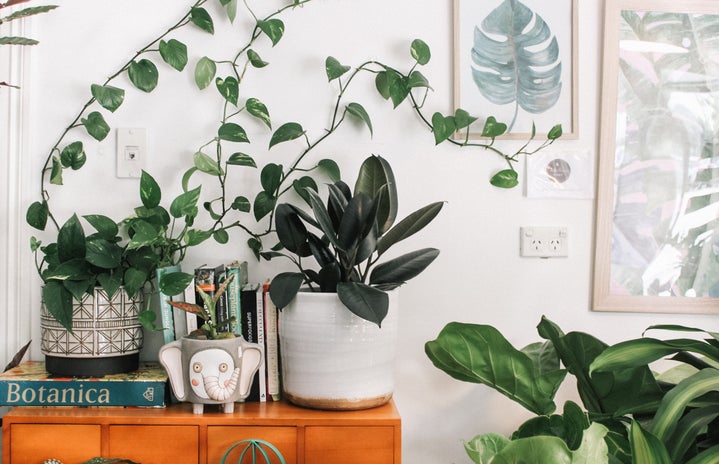As the days get shorter and the days get colder, we know that we need to trade in our Birks for boots and opt for hot coffee instead of an iced one. But there is one area of our lives that doesn’t receive the TLC that they need and deserve. That is our plant parenting. But today, I’m going to be sharing some tips and tricks to make sure that you don’t lose too many plants this winter.
Opt for Winter Friendly Houseplants
Now might not be the best time to pick up another alocasia. (Side note: I hate those little wh*res but that’s a story for another time.) If you want to purchase a plant during the winter months, look for something more forgiving. Christmas cactuses are great because they are tolerant to low light, cold weather and bloom during the holiday season. Generally, look for plants with hearty foliage and that can tolerate low light. I will definitely write an article about what constitutes low light and what plants are tolerant to lower light levels in the future so stay tuned for that.
Keep Plants Away from Drafts
Whether it be a window or a heater, your plants will not appreciate sudden changes in temperature. If your plant is near a window, make sure the leaves are not touching the window, and make sure the plant isn’t chilly. Physically pick up your pot and feel it. If it is cold to the touch, move it farther away from the light source or supplement with grow lights. You can also use a plant heater to warm up your plants in extra chilly spots.
Humidity Level
When we are running heaters, a lot of the moisture is taken out of the air. Especially with tropical plants like monsteras, calatheas, or alocasias, you need to maintain humidity. There are a lot of ways you can increase your humidity.
One way is to crowd plants together. Plants naturally release water through a process called transpiration. The water that the plant release will end up in the air and by crowding plants together, they all will benefit from this humidity boost. Something else you can do is to repurpose an essential oil diffuser to release water into the air (just ensure that your humidity doesn’t go over 50%. One last tip is to leave small cups of water around your plants so that the water will evaporate into the air. Just make sure that you are watching for fungus gnats. For plants that require humidity over 50%, you can also cover the plant in a plastic bag.
Grow Lights
Grow lights are an absolute game changer! Whether you don’t have access to a lot of light, or the windowsill is too chilly to leave your plants on, grow lights are incredible. There are three routes you can go down. The first is purchasing individual lights for plants. The thing is, these are just as expensive or more expensive than the other options so I wouldn’t recommend them. But if you only have a few plants and want your plants to still look aesthetically pleasing, this may be the way to go. Second, you can use this full spectrum grow lamp. This is the choice that I personally have gone with. The great thing about this light is that it features UV LED lights that are designed with plants in mind, unlike our artificial lights that lack blue and red light that plants need to grow. Finally, you can replace a lamp with a grow light bulb. This is definitely the cheapest option out of all of these. Another thing to keep in mind when supplementing sunlight with grow lights is to be aware that sunlight is stronger than grow lights. To make up for this, you should leave a plant that requires 6 hours of sunlight under grow lights for 12-14 hours. (SF Gate)
Water
This is one area of plant parenthood that you can back off for a little bit. Even with all of these tips, plants may stop growing for winter. This means that watering needs to be reduced. To see whether or not it is time to water, feel your plant’s leaves. If they are flimsy and soft, it is time to water.
Fertilize
Again, because often stop growing in the winter, fertilizer is not necessary. So hold that Miracle-Gro until springtime. If one of your plants like a Pothos is really flourishing during winter, you can give them fertilizer at ¼ the strength but don’t go above that.
Clean Your Leaves
This not only gets the dust off of your leaves but helps them to better photosynthesize. I like to wipe all of my leaves down with neem oil which makes leaves shiny and prevents pests. Be sure to do this at night because neem oil + sunlight = burnt leaves. Then, the next morning before the sun comes up, I wipe off all of the neem oil. I promise you; this process is long and tedious but oh so satisfying.
Propagating
Since we are exiting the growing season, I would highly recommend holding off chopping and propping until spring. This of course does not apply for removing dying or diseased leaves that can be removed by cutting the leaf off close to the stem.
Just as a closing statement, I wanted to encourage you to not give up hope if a few of your houseplants pass away in the winter. It happens to the best of us. Having a “green thumb” is not something that you are born with. It is developed through trial and error and lots and lots of research. But hopefully, this article helped provide some ways to get your plants ready for this upcoming winter.
If you like this article, check us out on Twitter and Instagram @hercampuscwu

